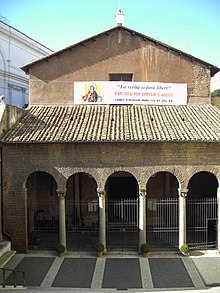San Vitale, Rome
This article needs additional citations for verification. (September 2017) |
| Basilica of Sts. Vitalis, Valeris, Gervase and Protase Basilica di Santi Vitale e Compagni Martiri in Fovea (in Italian) Basilica Ss. Vitalis, Valeriae, Gervasii et Protasii(in Latin) | |
|---|---|
 Façade of the Basilica of San Vitale | |
| Religion | |
| Affiliation | Roman Catholic |
| Ecclesiastical or organizational status | Minor basilica |
| Leadership | Adam Maida |
| Year consecrated | 401 |
| Location | |
| Location | |
| Geographic coordinates | 41°53′58.8″N 12°29′27.1″E / 41.899667°N 12.490861°ECoordinates: 41°53′58.8″N 12°29′27.1″E / 41.899667°N 12.490861°E |
| Architecture | |
| Type | Church |
| Style | Roman |
| Groundbreaking | ca. 400 |
| Specifications | |
| Direction of façade | SE |
| Length | 60 metres (200 ft) |
| Width | 18 metres (59 ft) |
| Website | |
| Official website | |
The Basilica of Sts. Vitalis, Valeris, Gervase and Protase (Italian: Basilica di Santi Vitale e Compagni Martiri in Fovea, Latin: Ss. Vitalis, Valeriae, Gervasii et Protasii) is an ancient Catholic church in Rome, and is both a minor basilica and a titular cardinalatial title. It is commonly called the Basilica di San Vitale.
History[]
The basilica was built in 400 with funds provided by Vestina, a wealthy dowager,[1] and was consecrated by Pope Innocent I in 401/402. The dedication to St. Vitalis and his family (Saint Valeria, his wife, and Sts. Gervasius and Protasius, their sons) is dated to 412. This church is recorded as Titulus Vestinae in the acts of the 499 synod of Pope Symmachus, and three priests are listed.
San Vitale was restored several times, most importantly when it was extensively rebuilt by Pope Sixtus IV before the Jubilee of 1475. Other interventions took place in 1598, 1938 and 1960. Because of changes in the city over the centuries, the floor level of the church is now several metres below the level of the street on which it is located, the present-day (via Nazionale).
Architectural and Artistic Features[]
Exterior[]
The portico is the most ancient part of the church, possibly dating back to the 5th century. It was altered at the end of the 16th century. The inscription on the portico, with the arms of Pope Sixtus IV, dates from this time. Pope Pius IX built the staircase to the 5th century portico in 1859.
Interior[]
The church has a single nave, with walls frescoed with scenes of martyrdom, among which a Martyrdom of St Ignatius of Antioch, in which a ruined Colosseum is depicted. The apse, a surviving part of the original 5th century church, is decorated with a fresco by Andrea Commodi, The Ascent to Calvary.

Cardinal Priest of the Basilica di San Vitale[]
Among the cardinals who previously took their title from the church were , appointed in 494 by Pope Gelasius I, and St. John Fisher, martyred in 1535 by Henry VIII. The current Cardinal Priest is Cardinal Adam Maida.
Customs[]
Free bread was distributed to the poor by the church according to the will of a Roman nobleman, Francesco Silla.
References[]
- ^ David Hunt, Chapter VIII of The Cambridge Ancient History, Volume XIII, p.251
Bibliography[]
- Armellini, Mariano (1891). Le chiese di Roma dal secolo IV al XIX (in Italian). Roma: Edizioni del Pasquino. pp. 187–189.
- Krautheimer, Richard; Spencer Corbett; Volfango Frankl (1970). Corpus basilicarum Christianarum Romae: Le basiliche cristiane antiche di Roma. Monumenti di antichità cristiana : ser. 2, v. 2. Citta del Vaticano: Pontificio istituto di archeologia cristiana. pp. 313 ff.
External links[]
| Wikimedia Commons has media related to San Vitale (Rome). |
- 401 establishments
- 5th-century churches
- 5th-century establishments in Italy
- 5th-century establishments in the Roman Empire
- 15th-century Roman Catholic church buildings in Italy
- Basilica churches in Rome
- Churches of Rome (rione Monti)
- Titular churches

